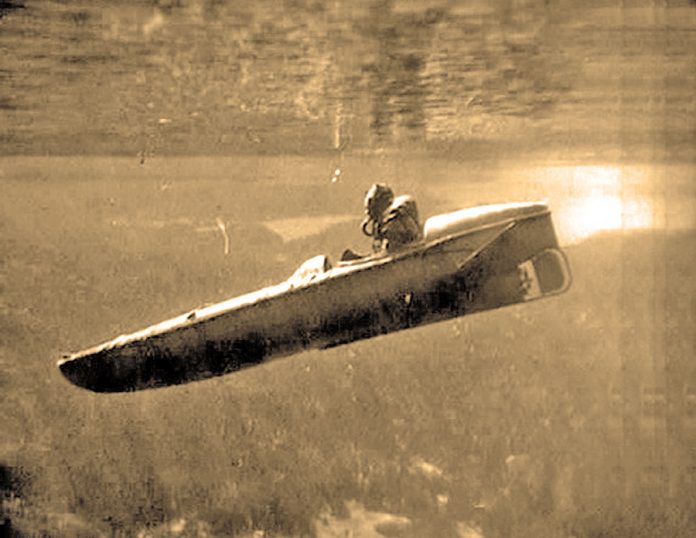
This Week: The Mysterious O.S.S.
The coronavirus has plunged Catalina Island into a crisis not seen since World War II. Much like today, the island underwent dramatic changes for those who lived here almost overnight. To recall those days, The Catalina Islander is reprinting the series “Fortress Catalina: The Island at War.”
Of the four military organizations that established a presence on Catalina during World War II, none matches the mystique of the legendary O.S.S., an organization so secret that I’ll wager you don’t even know what O.S.S. stands for.
Toyon Bay was first leased to the O.S.S.— the Office of Strategic Services—in 1943, but it wasn’t until June of 1944 that training operations actually began there. Operatives participated in myriad training activities and often spent weeks in the hills living off the land as part of their training, which no doubt meant lots of goat sandwiches. The organization was so successful at keeping its activities secret, that even most islanders had no idea the group was here until after the war.
Under the command of General William J. “Wild Bill” Donovan, operatives were prepared to land behind enemy lines during the Burma Campaign mainly in an effort to recruit locals to help the Allies wage war against the Japanese occupiers. Because Japanese troops were so despised in that region, the O.S.S. agents usually had little difficulty in getting local recruits.
Isolated locations on Catalina Island such as Toyon Bay, Howland’s Landing and Fourth of July Cove were used as stand-ins for coastal areas in Southeast Asia and the islands of the South Pacific. Many of the facilities, including Toyon Bay, had the added benefit of being protected from prying eyes in the sky by dense vegetation.
Many of the O.S.S. operatives hailed from some of America’s finest educational institutions at the time, such as Harvard, Yale, and Princeton. In fact, the ideal agent was described as a “Ph.D. who can win a bar fight.”
O.S.S. agents used a number of innovative weapons and gadgets, including silenced pistols, the secretive “glove gun,” cameras disguised as matchbooks, cigarette guns and numerous other devices.
Once deployed, Catalina O.S.S. agents were instrumental in enlisting the services of groups as varied as the famed Kachin Rangers to real-life headhunters from the jungles of Southeast Asia.
Of special note at the Catalina O.S.S. base was the training of “Detachment 101”, a group of Japanese-American volunteers, at least four of whom had come straight from internment camps on the West Coast.
In the closing months of the war, the Catalina O.S.S. base became headquarters for “Operation Napko”. Similar to Detachment 101, Operation Napko involved the training of Koreans and Korean-Americans for similar behind-the-line operations on the Korean Peninsula and even the Japanese mainland itself. Unlike Detachment 101, however, the end of the war spelled the end of Operation Napko before any of the operatives were deployed.
One of the more exotic activities undertaken at Toyon Bay during the war may have been what paranormal researchers dub “remote viewing,” this due to the presence of two operatives at Toyon Bay—E. Howard Hunt and Lucien Conein—who became heavily involved in the CIA’s remote viewing program after the war.
Though fantastic in concept, remote viewing is a simple idea in practice. Essentially, a group of people deemed by researchers as being “psychic” are put into a room and given a sheet of paper and a pencil. They are then instructed to draw a sketch of a “target” assigned by the group leader. This target can be anything from an object in the next room to an island on the other side of the world.
The military advantages of such a program are obvious and as wild as the idea sounds, it wasn’t wild enough for Britain’s Royal Air Force, the CIA and, later, the U.S. Air Force to dabble in this borderline black art.
During the Battle of Britain, for example, the UK’s intelligence wing known as MI6 had experimented with remote viewing in a desperate bid to gain intelligence on German positions in this pre-satellite era. In the mid-1970s, the U.S. Air Force operated their own program called “Stargate Project” after picking it up from the CIA.
While the jury is still out as to whether or not remote viewing is worth the paper it is sketched on, the U.S. Air Force apparently thought enough of it to keep the effort going into the 1990s.
By the end of 1944, the war was beginning to wind down in both the European and Pacific theaters and Americans were anxious to get back to their normal lives. The people of Catalina had had enough of the war.
But the war was not yet finished with Catalina.
Next Week: The Wreck of K111









